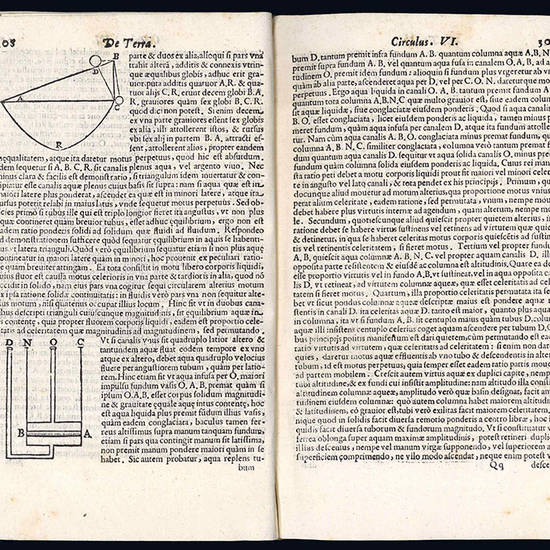Circulus Pisanus Claudii Berigardi Molinensis olim in Pisano, jam in Lyceo Patavino philosophi prim. De veteri et peripatetica philosophia in Aristotelis libros octo Physicorum. Quatuor de cœlo. Duos de ortu & interitu. Quatuor de meteoris, & tres de anima… Opus in hac secunda editione auctius & retractatius
Autore: BÉRIGARD, Claude Guillermet de (ca. 1590-1663)
Tipografo: Paolo Frambotto
Dati tipografici: Padova, 1660
Six parts in one volume, 4to (220x160 mm). [20], 64, [2 blank], [6], 65-203, [3 blank], [6], 205-353, [3 blank], [6], 357-538, [2 blank], [4], 541-583, [1 blank], [6], 585-729, [25] pp. Lacking 2 blank leaves (before pp. 357 and 585). At the beginning of the volume are wrongly bound 12 unnumbered leaves of index which do not belong to this edition. Every part opens with a separate title-page bearing the printer's device. Part 2, 3, 4 are dated 1660, while parts 1, 5, 6 are dated 1661. With decorated initials, head- and end-pieces. With the author's portrait on l. ++4v engraved by Giovanni Giorgi and many diagrams in the text. Early 19th century half-calf, richly gilt decorated spine with gilt title on red morocco label. Contemporary ownership's inscription on the second front fly-leaf: “Hic liber est Ippoliti de [not readable]. A few gatherings browned, some marginal foxing, but a very good, crisp copy.
SECOND GREATLY ENLARGED EDITION. The work is based on Bérigard's lectures at the University of Pisa. Compared to the first edition, which had appeared at Udine in 1642-43, this new edition was completely revised and substantially augmented.
The Circulus pisanus is a dialogue between Charilaus, a follower of Aristotelian philosophy, and Aristaeus, who upholds pre-Socratic philosophy (in particular the atomism of the so-called Ionians philosophers, i.e. Anaximander, Empedocles and Anaxagoras). The book is thus titled in memory of the “disputationes circulares”, i.e. the academic disputations which played an important part in the author's teaching at the University of Pisa. Because atomism as well as the new astronomical discoveries had been condemned, Bérigard was very cautious about how he recovered ancient doctrines and dealt with the new philosophy. Even though officially he safely remained within the limits of the traditional thought, Bérigard is clearly familiar with the particulate (probably Cartesian) and experimental (Galilean) forms of the new philosophy. He describes many experiments in his book, including those on vacuum and the fall of bodies.
Claude Guillermet Bérigard (or Beauregard or, Italianized, Berigardo) was born at Moulins in France around 1590, even though other sources (Niceron) set the date at 1578. He studied medicine and philosophy and took a degree in “artibus” at the University of Aix-en-Provence. He lived for a while in Lyons and Paris, before moving in 1625 to Tuscany, possibly summoned by Christine de Lorraine. From 1627 to 1638 he taught in Pisa, then from 1639 to the end of his life in Padua. In 1632 he published the Dubitationes in Dialogum Galilaei Galilaei, the first written attack against Galileo's Dialogo sopra i due massimi sistemi del mondo. Bérigard, who must have known Galileo personally, always praised Galileo (there is a Galilaei encomium on p. 563 of the Circulus Pisanus), but remained firmly convinced of the earth's immobility.
Many scientists of the time are mentioned with admiration in the present work: Galileo, Torricelli, Viviani, Cabeus, Bourdin, Boulliau, Mersenne, Descartes, Digby, Kircher, Thomas Bartholin, Borelli, Copernicus, Harvey, and Hobbes. Gassendi is also quoted; although the relationship between the latter and Bérigard is not very clear, it is certain that the second edition of the Circulus shows the influence of Gassendi's Syntagma philosophicum (1658). It should be also noted that as early as 1633 Mersenne and Peiresc called Gassendi's attention to the Dubitationes. However, Bérigard explicitly points out the difference between his atomism and that of Gassendi.
Though its author seems reluctant to fully cross the borders of the old philosophy, the Circulus Pisanus is undeniably a tribute to the new experimental sciences: beside the aforementioned Galileo's eulogy, the Copernican hypothesis is mentioned and “accepted” (the author says that the only way it can be confuted is through the authority of the Bible); the experiments of Torricelli are used to deny the vacuum only on the basis of the fact that God is everywhere and therefore the void cannot exist; the praise of the telescope or the comment on De Luna become an exposition of Copernicus' and Galileo's doctrines.
Cf. P. Ragnisco, Da Giacomo Zabarella a Claudio Berigardo, ossia prima e dopo Galileo nell'Università di Padova, in: “Atti Ist. Veneto Scienze, Lettere e Arti”, ser VII, V, 1893-94, I, pp. 477-518; A. Favaro, Oppositori di Galileo, IV: Claudio Berigardo, in: “Atti Ist. Veneto Scienze, Lettere e Arti”, LXXIX, 1919-20, II, pp. 39-92; A. Cecchini Degan, Nuovi studi su Claudio Berigardo, Padua, 1971; G. Stabile, Claude Bérigard (1592-1663). Contributo alla storia dell'atomismo seicentesco, Rome, 1975; G. Santinello, et al., Models of the History of Philosophy. I: From its Origins in the Renaissance to the “Historia Philosophica”, Dordrecht, Boston & London, 1993, p. 147 and fl.; R. French, William Harvey's Natural Philosophy, Cambridge, 2006, p. 246 and fl.
Carli & Favaro, 277; D.B.I., VII, pp. 388-89; Hirsch, I, p. 348; D.S.B., II, pp. 12-14.
[4760]











